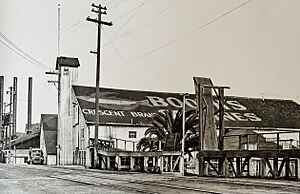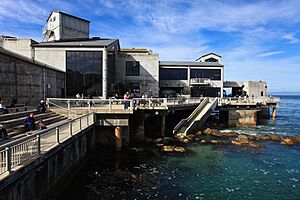Cannery Row facts for kids
Cannery Row is a famous street in Monterey, California. It used to be a busy place where people canned sardines. The street was first called Ocean View Avenue. It got its nickname 'Cannery Row' around 1918 and was officially renamed in 1958.
The area became famous because of John Steinbeck's books, Cannery Row (1945) and Sweet Thursday (1954). The sardine canning business in Monterey started in 1902. A man named Frank E. Booth bought a cannery and began canning sardines. He hired experts like Knut Hovden and Pietro Ferrante to make the cannery better and get more fish.
During World War I, the demand for canned food grew a lot. This caused many new canneries to be built along the shoreline. At its busiest, there were 30 canneries and processing plants on Ocean View Avenue. But by the early 1950s, the sardines disappeared. The canneries slowly closed down. The last one shut its doors in 1973.
Over time, people turned the old cannery buildings into restaurants, hotels, and shops. The place where the Hovden Cannery once stood is now home to the Monterey Bay Aquarium. It opened in October 1984.
Contents
What is Cannery Row Today?
Cannery Row is a popular street in Monterey, California. It was once called Ocean View Avenue. It was renamed in 1958 to honor John Steinbeck's famous novel. The street follows the natural curve of the coast. It stretches from San Carlos Beach towards Lovers Point in Pacific Grove.
Monterey is about 25 miles (40 km) south of Santa Cruz. It is also 1 mile (1.6 km) southeast of Pacific Grove. Cannery Row still has several old buildings that tell its history. These include parts of the Hovden Cannery (built in 1916) and the Monterey Canning Company Warehouse (1918). Other historic spots are the Wing Chong Market (1918) and the Pacific Biological Laboratories (1937).
The Story of Cannery Row
Monterey's sardine industry began in the early 1900s. Over the next 50 years, it became the top fishing port in the country. During World War I, more canned goods were needed. This made the industry grow very fast. Many new canneries were built, creating a long line of factories along Ocean View Avenue. This is when the name "Cannery Row" became popular.
In the early 1940s, during its busiest time, 30 canneries and processing plants lined the street. Each cannery had its own colorful sardine label and a special whistle. These whistles called workers to their shifts. Business slowed during the Great Depression. However, it picked up again during World War II.
After the war, the number of sardines in Monterey Bay dropped sharply. Soon, they disappeared completely. The canneries and packing houses closed one by one. The Hovden Cannery was the last to close in 1973. Its old building site later became the Monterey Bay Aquarium.
How the Sardine Industry Started (1902–1919)
In 1902, Frank E. Booth bought a cannery that was not doing well. He first planned to can salmon. But he saw many sardines in Monterey Bay and decided to can them instead. A fire destroyed Booth's cannery in 1903. He rebuilt it bigger and named his new company the F.E. Booth Cannery.
The first large cannery on Ocean View Avenue was the Monterey Fishing and Canning Company. It opened in March 1902. It was later sold and renamed the Pacific Fish Company in 1908.
Booth hired Knut Hovden, an expert engineer, in 1905. Hovden helped make the business more modern. Booth also worked with Sicilian fishermen Pietro Ferrante and Orrazio Enea. They helped bring in many Sicilian workers and improved fishing methods. This made sure the canneries had a steady supply of sardines. Ferrante introduced a special fishing net called the Lampara net. This net greatly increased the amount of fish caught. In 1913, Hovden created a modern assembly-line system for canning sardines on a large scale.
Demand for Monterey sardines grew a lot in 1914. This was because France stopped exporting sardines due to World War I. The U.S. government encouraged people to eat canned fish. Canned fish was easy to send overseas to feed soldiers and people in Europe. This demand caused a huge growth in the canning industry, especially for sardines. Posters were even made to show how canning helped the war effort. Booth's Cannery became one of California's largest fish canneries.
The growing demand also inspired others, like Knut Hovden, to build their own canneries. These new plants were built on Ocean View Avenue starting in 1916. The street soon became known as Cannery Row. By 1918, the canneries were producing 1.4 million sardine cans each year. New canneries built during this time included Hovden Food Products and Monterey Canning Company.
The Busiest Years (1920–1946)
The busy canneries and processing plants hired many people. Fishermen were mostly Sicilian and Japanese. Cannery workers came from many backgrounds, including Portuguese, Sicilians, Hispanic, Chinese, and Anglo-Europeans. Many of these workers were women and children. In the 1930s and 1940s, Sicilian women made up about 30% of the cannery workers. They usually packed the sardine cans.
Before machines took over, Asian and Hispanic men and women cut the fish. White men often handled the machines, like the boilers that cooked the fish. Work at the cannery depended on when the sardines were caught. There was not much work from March to September. But from October to February, when boats came in full of fish, workers were called by their plant's whistle. They worked long shifts, sometimes 12 to 15 hours, until all the fish were canned or processed.
In the early 1940s, more than 24 canneries and processing plants were working on Cannery Row. The amount of sardines caught changed a lot each year. At its peak, the canneries employed 3,000 to 4,000 people. This was almost half of Monterey's 10,000 residents. These jobs included fishing, canning, and processing.
Even during slow times, canneries made money by processing fish meal. The industry slowed down during the Great Depression. However, demand increased again during World War II. This led to another boom for canning and more canneries were built.
When the Industry Slowed Down (1947–1973)
The decline of Monterey's sardine fishing was likely due to several reasons. These included too much fishing, changes in ocean currents and temperatures, and natural sardine life cycles. In 1946, at the peak of production, 142,282 tons of sardines were caught. Just one year later, the catch dropped to only 26,818 tons.
Many factories closed in the late 1940s and early 1950s. The Hovden Cannery stayed open until 1973 by canning squid instead of sardines. By 1958, only five struggling canneries remained. They were no longer packing sardines. Instead, they canned tuna, anchovy, and mackerel. The California Packing Company, one of the oldest and largest canneries, closed in 1962. Investors bought the empty waterfront properties. They wanted to use them for California's growing tourism industry.
Cannery Row in Books and Movies
The Cannery Row waterfront became famous through John Steinbeck's novels. These were Cannery Row (1945) and Sweet Thursday (1954). The first book is set during the Great Depression. Steinbeck described Cannery Row as "a poem, a stink, a grating noise, a quality of light, a tone, a habit, a nostalgia, a dream."
The story is about Doc, a local marine biologist. It also features his friends, a group of unemployed men, and other people living on Cannery Row. The Pacific Biological Laboratories was a place that supplied biological items. It was run by Edward F. Ricketts. He was the real-life inspiration for the character Doc in Steinbeck's books.
The building at 800 Cannery Row today replaced an older one. The first building burned down in a fire in 1936. The City of Monterey offers tours of the preserved laboratory and Rickett's family home. Across from the laboratory is the old Wing Chong Company grocery store. This store was featured in both Cannery Row and Sweet Thursday. It is no longer a grocery store but now holds several shops. Across the street from Rickett's laboratory is an empty lot. This was the "home" for some of the homeless characters in the novel. Today, it has three small replicas of cannery worker cottages.
The 1982 movie Cannery Row was based on Steinbeck’s novels. It starred Nick Nolte and Debra Winger.
Cannery Row for Visitors
Today, Cannery Row is a popular tourist attraction. It has many restaurants and hotels. Several of these are in the old cannery buildings. The Monterey Bay Aquarium is at the north end of Cannery Row. The aquarium is built on the site of the Hovden Cannery. This cannery was built in 1916 and was the last one in Monterey to close in 1973.
The aquarium was built around the cannery's old boiler house. This boiler house is kept as a public exhibit, but it no longer works. When the aquarium opened on October 20, 1984, it was the largest public aquarium in the United States. The aquarium focuses on sea life found in Monterey Bay. It was also the first aquarium to show a living kelp forest. Nearly two million people visit the aquarium each year. The organization also does research and works to protect marine animals, birds, and fish.
See also
- Canned fish
- John Steinbeck bibliography
- List of canneries
- Sardines as food
Images for kids















